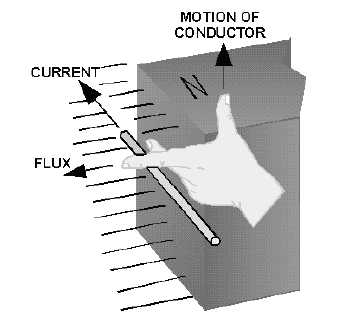1-2
The AMOUNT of voltage generated depends on (1) the strength of the magnetic field, (2) the angle
at which the conductor cuts the magnetic field, (3) the speed at which the conductor is moved, and (4) the
length of the conductor within the magnetic field.
The POLARITY of the voltage depends on the direction of the magnetic lines of flux and the
direction of movement of the conductor. To determine the direction of current in a given situation, the
LEFT-HAND RULE FOR GENERATORS is used. This rule is explained in the following manner.
Extend the thumb, forefinger, and middle finger of your left hand at right angles to one another, as
shown in figure 1-1. Point your thumb in the direction the conductor is being moved. Point your
forefinger in the direction of magnetic flux (from north to south). Your middle finger will then point in
the direction of current flow in an external circuit to which the voltage is applied.
Figure 1-1.—Left-hand rule for generators.
THE ELEMENTARY GENERATOR
The simplest elementary generator that can be built is an ac generator. Basic generating principles
are most easily explained through the use of the elementary ac generator. For this reason, the ac generator
will be discussed first. The dc generator will be discussed later.
An elementary generator (fig. 1-2) consists of a wire loop placed so that it can be rotated in a
stationary magnetic field. This will produce an induced emf in the loop. Sliding contacts (brushes)
connect the loop to an external circuit load in order to pick up or use the induced emf.

